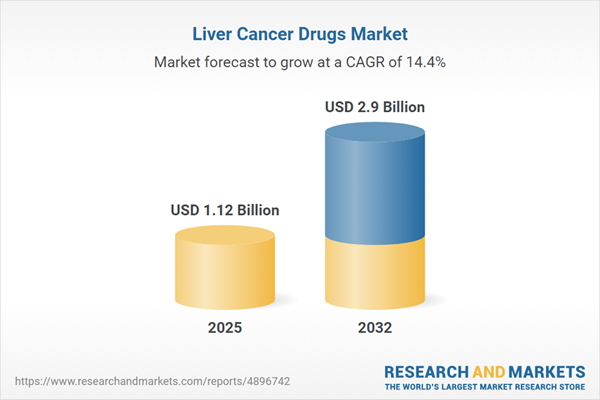Speak directly to the analyst to clarify any post sales queries you may have.
The liver cancer drugs market is undergoing transformation as treatment innovations, digital solutions, and updated regulatory frameworks prompt senior leaders to reassess operational strategies. In this competitive, opportunity-rich environment, timely insights are essential for aligning organizational priorities and capitalizing on growth.
Liver Cancer Drugs Market Snapshot
The liver cancer drugs market demonstrates ongoing, resilient expansion. Growth is powered by advancements in therapeutic pipelines and the adoption of personalized oncology, as organizations pivot to address evolving regulatory and reimbursement requirements. Market leaders are adjusting operations and redefining pathways to enhance access while navigating sector-specific challenges. Emphasis on targeted therapies and adaptive care models reflects a broader need for organizational agility. The market’s rapid development minimizes the margin for error, prompting leaders to keep pace with scientific breakthroughs and shifting standards. Staying responsive and informed is crucial for sustaining a competitive edge as operational and clinical benchmarks evolve.
Liver Cancer Drugs Market: Scope & Segmentation
This analysis offers actionable intelligence for senior decision-makers seeking comprehensive strategic guidance across the liver cancer drugs landscape.
- Therapy Types: Chemotherapy, immunotherapy, radiation, and targeted therapies enable tailoring of treatments to varying patient needs and promote flexibility in clinical protocols.
- Cancer Types: The report scrutinizes hepatocellular carcinoma, cholangiocarcinoma, and hepatoblastoma, highlighting unique clinical needs and guiding local development initiatives.
- Administration Routes: Examination covers intravenous, oral, and subcutaneous delivery options, broadening access and facilitating decentralized care structures.
- Drug Classes: Focus on cytotoxic agents, monoclonal antibodies, and tyrosine kinase inhibitors illustrates the ongoing shift to more precise and patient-centered solutions.
- End Users: Assessment of hospitals, specialty clinics, and home care settings provides insight into how patient access and efficiency are evolving within new care models.
- Distribution Channels: Exploration of hospital pharmacies, retail providers, and digital distribution channels spotlights the need for responsive supply strategies as demand patterns and patient preferences change.
- Regions Covered: Dynamics across the Americas, Europe, Middle East, Africa, and Asia-Pacific are detailed, underscoring the critical influence of regional health infrastructure and regulatory compliance on market strategies.
- Key Companies: Coverage includes Bayer AG, Eisai Co., Ltd., Bristol-Myers Squibb Company, Merck & Co., F. Hoffmann-La Roche Ltd, Ipsen S.A., AstraZeneca plc, and Exelixis, Inc., revealing how leading investments and partnerships are shaping both global and local market direction.
Key Takeaways for Senior Decision-Makers
- Accelerated clinical trial models and evolving timelines are increasing the market’s competitiveness and altering time-to-market for leading therapies.
- Adoption of oral and subcutaneous therapies is diversifying patient care pathways, promoting workflow improvements and supporting the expansion of home-based and decentralized care delivery.
- Integration of biomarker-guided diagnostics is optimizing pathway selection and enhancing long-term planning for therapy portfolios.
- Advanced analytics and digital health applications are strengthening decision-making by enabling more effective real-world evidence use across regulatory and collaborative environments.
- Strategic investments in supply chain resilience, particularly in Asia-Pacific and EMEA regions, remain essential for stable market access and ongoing compliance with changing regulations.
- Greater industry collaboration is leading to enhanced supply and distribution systems, allowing organizations to swiftly respond to shifts in market demand.
Tariff Impact and Supply Chain Strategy
Recent U.S. tariff changes have affected both production expenses and pricing models for manufacturers in the liver cancer drugs sector. To manage these impacts, organizations are shifting to localized production, enhancing logistics, and developing stronger connections with primary suppliers. These measures are aimed at reducing disruptions and maintaining stable therapy access even under volatile market conditions.
Methodology & Data Sources
Findings in this liver cancer drugs market report are based on rigorous analysis of peer-reviewed scientific publications, regulatory documentation, and contemporary clinical trial outcomes. Perspectives drawn from expert panels and synthesized anonymized datasets provide objective and relevant insights for senior decision-makers.
Why This Liver Cancer Drugs Market Report Matters
- Empowers executives to shape strategic and operational plans with robust market intelligence and relevant, timely insights.
- Offers forward-looking guidance on navigating regulatory and industry shifts, ensuring readiness for compliance and emerging challenges.
- Supports innovation in supply chain models and distribution, expanding access and enabling the sustainable adoption of advanced therapies.
Conclusion
Leveraging this report enables senior leadership teams to make well-informed, future-minded decisions as the liver cancer drugs market continues to evolve and new opportunities emerge.
Additional Product Information:
- Purchase of this report includes 1 year online access with quarterly updates.
- This report can be updated on request. Please contact our Customer Experience team using the Ask a Question widget on our website.
Table of Contents
3. Executive Summary
4. Market Overview
7. Cumulative Impact of Artificial Intelligence 2025
List of Figures
Companies Mentioned
The companies profiled in this Liver Cancer Drugs market report include:- Bayer AG
- Eisai Co., Ltd.
- Bristol-Myers Squibb Company
- Merck & Co., Inc.
- F. Hoffmann-La Roche Ltd
- Ipsen S.A.
- AstraZeneca PLC
- Exelixis, Inc.
Table Information
| Report Attribute | Details |
|---|---|
| No. of Pages | 180 |
| Published | November 2025 |
| Forecast Period | 2025 - 2032 |
| Estimated Market Value ( USD | $ 1.12 Billion |
| Forecasted Market Value ( USD | $ 2.9 Billion |
| Compound Annual Growth Rate | 14.4% |
| Regions Covered | Global |
| No. of Companies Mentioned | 9 |









